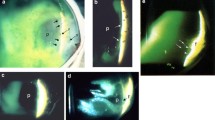Abstract
• Background
It is believed that the vascular or primary vitreous, with the exception of the later Cloquet's canal, gradually disappears and is substituted by the avascular or secondary vitreous. It ] is known that it is possible topographically to objectify mats of fibril concentrations (membranelles or tractus) of stronger light reflection inside the adult vitreous. These concentrations open up in the shape of a funnel from the papilla or Cloquet's canal towards the front of the vitreous.
• Methods
This was a light microscopy investigation on human eyes between the embryonal stage of 3.2 cm and the fetal stage of 12.5 cm and eyes 8 months and 2 years old with persistent vessels of the vitreous.
• Results
The investigation showed that at the embryonal stage the vitreous body is threaded from behind by branches (mats) of the hyaloid artery and from in front by vessels (mats) that go over the rim of the optic cup, i.e., the later vitreous base. Vitreous structures, in the form of horsetail-shaped fibril concentrations, could already be observed histologically in the fetal stage with the disappearance of embryonal blood vessels. These structures begin in the vitreous base, go into the vitreous, run parallel to the retina, and then go to the back of the vitreous and towards the lens. The physiological mats of vitreal fibril concentrations (membranelles or tractus) and the pathological branches of the persistent hyaloid artery, topographically correspond to the mats of the obliterated embryonal blood vessels of the vitreous, These mats grow in relation to the bulbous growth.
• Conclusions
In these investigations an attempt has been made to clarify the question of which embryonal blood vessels, which embryonal and fetal lengths, which different physiological tractus of the vitreous body and which different pathological features of the persistent hyaloid artery correspond.
Similar content being viewed by others
References
Badtke G (1958) Die normale Entwicklung des menschlichen Auges. Der Augenarzt, vol 1. Thieme, Leipzig
Balazs EA (1982) Functional anatomy of the vitreous. In: Duane TD, Jaeger EA (eds) Biomedical foundations of Ophthalmology, vol 1. Harper and Row, Philadelphia, pp 6, 12
Balazs EA, Toth LZ, Ozanics V (1980) Cytological studies on the developing vitreous as related to the hyaloid vessels system. Graefe's Arch Clin Exp Ophthalmol 213:71–85
Busacca A (1957) Biomikroskopie et histopathologie de l'oeil, vols I, II. Zurich, Druck und Verlagshaus
Daicker B (1993) Glaskörperpathologie. Ophthalmologe 90:419–425
Déjean C (1958) Embryologic du corps vitré. In: Déjean C, Hervouet F, Leplat G (eds) L'embriologie de l'oeil et sa tératologie. Masson, Paris, pp 220–308
Duke Elder S Sir (1961) The anatomy of the visual system. System of Ophthalmology, vol II. Henry Kimpton, London
Duke Elder S Sir (1963) Normal and abnormal development. System of ophthalmology, vol III, Pt 1. Embryology. Henry Kimpton, London
Eisner G (1971) Autoptische Spaltlampenuntersuchung des Glaskörpers. I. Präparations- und Untersuchungstechnik. Graefe's Arch Clin Exp Ophthalmol 182:1–7
Eisner G (1971) Autoptische Spaltlampenuntersuchung des Glaskörpers. II. Die Spaltlampenmikroskopisch sichtbaren Glaskörperstrukturen. Graefe's Arch Clin Exp Ophthalmol 182:8–22
Eisner G (1971) Autoptische Spaltlampenuntersuchung des Glaskörpers. III. Beziehung zur Histologic, Biomikroskopie und Klinik. Graefe's Arch Clin Exp Ophthalmol 182:23–40
Eisner G (1973) Autoptische Spaltlampenuntersuchung des Glaskörpers. V. Der Glaskörper beim Kleinkind. Graefe's Arch Clin Exp Ophthalmol 187:5–20
Eisner G (1975) Zur Anatomic des Glaskörpers. Graefe's Arch Clin Exp Ophthalmol 193:33–56
Eisner G, Bachmann E (1974) Vergleichende morphologische Spaltlampenunteruschungen des Glaskörpers beim Rinde. Graefe's Arch Clin Exp Ophthalmol 191:329–342
Gärtner J (1962) Klinische Betrachtungen über den Zusammenhang der Glaskörpergrenzmembran mit Glaskörpergerüst und Netzhautgefäßen in der Ora-Äquatorgegend. Klin Monatsbl Augenheilkd 140:524–545
Gärtner J (1964) Über persistierende periphere vitreochorioidale GefäBanastomosen. Graefe's Arch Clin Exp Ophthalmol 166:474–493
Gärtner J (1964) Über persistierende netzhautadhärente Glaskörperstränge und vitreoretinale Gefäßanastomosen. Graefe's Arch Clin Exp Ophthalmol 167:103–121
Gärtner J (1965) Die Feinstruktur der Glaskörperrinde des menschlichen Auges an der ore serrata im Alter. Graefe's Arch Clin Exp Ophthalmol 168:529–562
Gärtner J (1965) Elektronenmikroskopische Untersuchungen über Glaskörperrindenzellen und Zonulafasern. Z Zellforsch 66:737–764
Gärtner J (1971) The fine structure of the vitreous base of the human eye and pathogenesis of pars planitis. Am J Ophthalmol 71:1317–1327
Gärtner J (1986) The vitreous, an intraocular compartment of the leptomeninx. Electron microscopic observations on rat eyes. Doc Ophthalmol 62:205–222
Jokl A (1927) Vergleichende Untersuchungen über den Ban und die Entwicklung des Glaskörpers und seiner Inhaltsgebilde bei Wirbeltieren und beim Menschen. Almquist und Wiksells, Uppsala, Stockholm
Lauber H (1931) Anatomic des Ciliarkörpers, der Aderhaut und des Glaskörpers. Handbuch der ges. Augenheilkunde, Vol 1, Pt 2. Springer, Berlin, pp 6, 57
Mann I (1964) The development of the human eye, 3rd edn. Grune and Statton, New York
Nußbaum M (1908) Entwicklung des Auges. Graefe-Saemisch Handbuch der ges. Augenheilkunde, Vol II. p 54
Pau H (1951) Betrachtungen zur Physiologie und Pathologic des Glaskörpers. Graefe's Arch Clin Exp Ophthalmol 152:201–247
Pau H (1965) Die Neubildung des Glaskörpers und seiner Fibrillen. Graefe's Arch Clin Exp Ophthalmol 168:521–528
Pau H (1969) de+Die Strukturen des Glaskörpers in Beziehung zu embryonalen Blutgefäßen und Glaskörperrindenzellen. Graefe's Arch Clin Exp Ophthalmol 177:261–270
Pau H (1969) Hyperplasie des Glaskörpergerüstes. Ophthalmologica. 159:166–177
Pau H, Stochdorph O (1957) Die Deutung der Glaskörperbegrenzung als modifiziertes Hirnhautgewebe. Graefe's Arch Clin Exp Ophthalmol 159:159–161
Reese AB (1955) Persistent hyperplastic primary vitreous. Am J Ophthalmol 40:317–331
Rohen JW (1979) Das Auge und seine Hilfsorgane. Handbuch der mikroskopischen Anatomie des Menschen, Vol 3, Pt 4. Springer, Berlin Heidelberg New York
Szent-Györgyi A (1917) Vergleichende Untersuchungen über den Ban und die Entwicklung des Glaskörpers beim Menschen. Arch Mikr Anat 89:324–386
Author information
Authors and Affiliations
Rights and permissions
About this article
Cite this article
Pau, H. Topography of the “vitreous structures” (tractus; membranelles) with respect to the layers of embryonal blood vessels. Graefe's Arch Clin Exp Ophthalmol 234, 199–204 (1996). https://doi.org/10.1007/BF00462033
Received:
Revised:
Accepted:
Issue Date:
DOI: https://doi.org/10.1007/BF00462033



